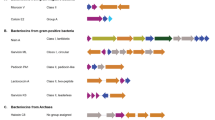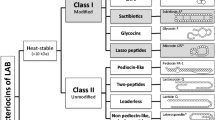Abstract
This commentary was aimed at shedding light on the multifunction of bacteriocins mainly those produced by lactic acid bacteria. These antibacterial agents were first used to improve food safety and quality. With the increasing antibiotic resistance concern worldwide, they have been considered as viable agents to replace or potentiate the fading abilities of conventional antibiotics to control human pathogens. Bacteriocins were also shown to have potential as antiviral agents, plant protection agents, and anticancer agents. Bacteriocins were reported to be involved in shaping bacterial communities through inter- and intra-specific interactions, conferring therefore to producing strains a probiotic added value. Furthermore, bacteriocins recently were shown as molecules with a fundamental impact on the resilience and virulence of some pathogens.
Similar content being viewed by others
References
Drider D, Rebuffat S (2011) Prokaryotic antimicrobial peptides: from genes to applications. Springer, New York
Perez RH, Zendo T, Sonomoto K (2014) Novel bacteriocins from lactic acid bacteria (LAB): various structures and applications. Microb Cell Fact 29(13 Suppl 1):S3
Messaoudi S, Kergourlay G, Rossero A, Ferchichi M, Prévost H, Drider D, Manai M, Dousset X (2011) Identification of lactobacilli residing in chicken ceca with antagonism against Campylobacter. Int Microbiol 14:103–110
Nazef L, Belguesmia Y, Tani A, Prévost H, Drider D (2008) Identification of lactic acid bacteria from poultry feces: evidence on anti-Campylobacter and anti-Listeria activities. Poult Sci 87:329–334
Line JE, Svetoch EA, Eruslanov BV, Perelygin VV, Mitsevich EV, Mitsevich IP, Levchuk VP, Svetoch OE, Seal BS, Siragusa GR, Stern NJ (2008) Isolation and purification of enterocin E-760 with broad antimicrobial activity against Gram-positive and Gram-negative bacteria. Antimicrob Agents Chemother 52:1094–1100
Kjos M, Borrero J, Opsata M, Birri DJ, Holo H, Cintas LM, Snipen L, Hernández PE, Nes IF, Diep DB (2011) Target recognition, resistance, immunity and genome mining of class II bacteriocins from Gram-positive bacteria. Microbiology 157:3256–3267
Draper LA, Cotter PD, Hill C, Ross RP (2015) Lantibiotic resistance. Microbiol Mol Biol Rev 79:171–191
Maldonado-Barragán A, Caballero-Guerrero B, Martín V, Ruiz-Barba JL, Rodríguez JM (2016) Purification and genetic characterization of gassericin E, a novel co-culture inducible bacteriocin from Lactobacillus gasseri EV1461 isolated from the vagina of a healthy woman. BMC Microbiol 12:16–37
Chanos P, Mygind T (2016) Co-culture-inducible bacteriocin production in lactic acid bacteria. Appl Microbiol Biotechnol 100:4297–4308
Gratia A, Fredericq P (1946) Diversite’ des souches antibiotiques de E. coli et étendue variable de leur champs d’action. Comptes Rendus Soc. Biol. (Paris) 140:1032–1033
Hammami R, Zouhir A, Le Lay C, Ben Hamida J, Fliss I (2010) BACTIBASE second release: a database and tool platform for bacteriocin characterization. BMC Microbiol 27(10):22. doi:10.1186/1471-2180-10-22
Hammami R, Zouhir A, Ben Hamida J, Fliss I (2007) BACTIBASE : a new web-accessible database for bacteriocin characterization. BMC Microbiol 7:89
Wang G, Li X, Wang Z (2016) APD3: the antimicrobial tide database as a tool for research and education. Nucleic Acids Res 44(D1):D1087–D1093
Jennsen H, Hamill P, Hancock REW (2006) Peptide antimicrobial agents. Clin Microbiol Rev 19:491–511
Montville TJ, Chen Y (1998) Mechanistic action of pediocin and nisin: recent progress and unresolved questions. Appl Microbiol Biotechnol 50:511–519
Breukink E, Wiedemann I, van Kraaij C, Kuipers OP, Sahl HG, de Kruijff B (1999) Use of the cell wall precursor lipid II by a pore-forming peptide antibiotic. Science 286:2361–2364
Wiedemann I, Breukink E, van Kraaij C, Kuipers OP, Bierbaum G, de Kruijff B, Sahl HG (2001) Specific binding of nisin to the peptidoglycan precursor lipid II combines pore formation and inhibition of cell wall biosynthesis for potent antibiotic activity. J Biol Chem 276:1772–1779
Hart P, Oppedijk SF, Breukink E, Martin NI (2016) New insights into nisin’s antibacterial mechanism revealed by binding studies with synthetic lipid II analogues. Biochemistry 55:232–237
Héchard Y, Sahl HG (2002) Mode of action of modified and unmodified bacteriocins from Gram-positive bacteria. Biochimie 84:545–557
Ramnath M, Arous S, Gravesen A, Hastings JW, Héchard Y (2004) Expression of mptC of Listeria monocytogenes induces sensitivity to class IIa bacteriocins in Lactococcus lactis. Microbiology 150:2663–2668
Drider D, Fimland G, Héchard Y, McMullen LM, Prévost H (2006) The continuing story of class IIa bacteriocins. Microbiol Mol Biol Rev 70:564–582
Cotter PD (2014) An ‘Upp’-turn in bacteriocin receptor identification. Mol Microbiol 92:1159–1163
Kjos M, Oppegård C, Diep DB, Nes IF, Veening JW, Nissen-Meyer J, Kristensen T (2014) Sensitivity to the two-peptide bacteriocin lactococcin G is dependent on UppP, an enzyme involved in cell-wall synthesis. Mol Microbiol 92:1177–1187
Bastos Mdo C, Coelho ML, Santos OC (2015) Resistance to bacteriocins produced by Gram-positive bacteria. Microbiology 161:683–700
Belguesmia Y, Madi A, Sperandio D, Merieau A, Feuilloley M, Prévost H, Drider D, Connil N (2011) Growing insights into the safety of bacteriocins: the case of enterocin S37. Res Microbiol 162:159–163
Das D, Goyal A (2014) Characterization of a noncytotoxic bacteriocin from probiotic Lactobacillus plantarum DM5 with potential as a food preservative. Food Funct 5:2453–2462
Santajit S, Indrawattana N (2016) Mechanisms of antimicrobial resistance in ESKAPE pathogens. Biomed Res Int 2016:2475067
Naghmouchi K, Drider D, Baah J, Teather R (2010) Nisin A and polymyxin B as synergistic inhibitors of Gram-positive and Gram-negative bacteria. Probiotics Antimicrob Prot 2:98–103
Naghmouchi K, Le Lay C, Baah J, Drider D (2012) Antibiotic and antimicrobial peptide combinations: synergistic inhibition of Pseudomonas fluorescens and antibiotic-resistant variants. Res Microbiol 163:101–108
Naghmouchi K, Baah J, Hober D, Jouy E, Rubrecht C, Sané F, Drider D (2013) Synergistic effect between colistin and bacteriocins in controlling Gram-negative pathogens and their potential to reduce antibiotic toxicity in mammalian epithelial cells. Antimicrob Agents Chemother 57:2719–2725
Lebel G, Piché F, Frenette M, Gottschalk M, Grenier D (2013) Antimicrobial activity of nisin against the swine pathogen Streptococcus suis and its synergistic interaction with antibiotics. Peptides 50:19–23
Mathur H, O’Connor PM, Hill C, Cotter PD, Ross RP (2013) Analysis of anti-Clostridium difficile activity of thuricin CD, vancomycin, metronidazole, ramoplanin, and actagardine, both singly and in paired combinations. Antimicrob Agents Chemother 57:2882–2886
Al Atya AK, Belguesmia Y, Chataigne G, Ravallec R, Vachée A, Szunerits S, Boukherroub R, Drider D (2016) Anti-MRSA activities of enterocins DD28 and DD93 and evidences on their role in the inhibition of biofilm formation. Front Microbiol 31:817
Mathur H, Rea MC, Cotter PD, Hill C, Ross RP (2016) The efficacy of thuricin CD, tigecycline, vancomycin, teicoplanin, rifampicin and nitazoxanide, independently and in paired combinations against Clostridium difficile biofilms and planktonic cells. Gut Pathog 8:20
Field D, O’Connor R, Cotter PD, Ross RP, Hill C (2016) In vitro activities of nisin and nisin derivatives alone and in combination with antibiotics against Staphylococcus biofilms. Front Microbiol 18:508
Wachsman MB, Farías ME, Takeda E, Sesma F, de Ruiz Holgado AP, de Torres RA, Coto CE (1999) Antiviral activity of enterocin CRL35 against herpesviruses. Int J Antimicrob Agents 12:293–299
Wachsman MB, Castilla V, de Ruiz Holgado AP, de Torres RA, Sesma F, Coto CE (2003) Enterocin CRL35 inhibits late stages of HSV-1 and HSV-2 replication in vitro. Antivir Res 58:17–24
Qureshi H, Saeed S, Ahmed S, Rasool SA (2006) Coliphage hsa as a model for antiviral studies/spectrum by some indigenous bacteriocin like inhibitory substances (BLIS). Pak J Pharm Sci 19:182–185
Todorov SD, Wachsman M, Tomé E, Dousset X, Destro MT, Dicks LM, Franco BD, Vaz-Velho M, Drider D (2010) Characterization of an antiviral pediocin-like bacteriocin produced by Enterococcus faecium. Food Microbiol 27:869–879
Quintana VM, Torres NI, Waschman MB, Sinko PJ, Castilla V, Chikindas M (2014) Antiherpes simplex virus type 2 activity of the antimicrobial peptide subtilosin. J Appl Microbiol 117:1253–1259
Férir G, Petrova MI, Andrei G, Huskens D, Hoorelbeke B, Snoeck R, Vanderleyden J, Balzarini J, Bartoschek S, Brönstrup M, Süssmuth RD, Schols D (2013) The lantibiotic peptide labyrinthopeptin A1 demonstrates broad anti-HIV and anti-HSV activity with potential for microbicidal applications. PLoS One 28(8):e64010
Al-Kassaa I, Hober D, Hamze M, Chihib NE, Drider D (2014) Antiviral potential of lactic acid bacteria and their bacteriocins. Probiotics Antimicrob Prot 6:177–185
Donia MS, Cimermancic P, Schulze CJ, Wieland Brown LC, Martin J, Mitreva M, Clardy J, Linington RG, Fischbach MA (2014) A systematic analysis of biosynthetic gene clusters in the human microbiome reveals a common family of antibiotics. Cell 158:1402–1414
Donia MS, Fischbach MA (2015) Small molecules from the human microbiota. Science 349:1254766
Kommineni S, Bretl DJ, Lam V, Chakraborty R, Hayward M, Simpson P, Cao Y, Bousounis P, Kristich CJ, Salzman NH (2015) Bacteriocin production augments niche competition by enterococci in the mammalian gastrointestinal tract. Nature 526:719–722
Guinane CM, Lawton EM, O’Connor PM, O’Sullivaan O, Hill C, Ross P, Cotter PD (2016) The bacteriocin bactofencin A subtly modulates gut microbial populations. Anaerobe 40:41–49
Kaur S, Kaur S (2015) Bacteriocins as potential anticancer agents. Front Pharmacol 10(6):272
Dobrzyńska I, Szachowicz-Petelska B, Figaszewski Z, Sulkowski S (2005) Changes in electric charge and phospholipid composition in human colorectal cancer cells. Mol Cell Biochem 276:113–119
Hoskin DW, Ramamoorthy A (2008) Studies on anticancer activities of antimicrobial peptides. Biochem Biophys Acta 1778:357–375
Martín R, Escobedo S, Martín C, Crespo A, Quiros LM, Suarez JE (2015) Surface glycosaminoglycans protect eukaryotic cells against membrane-driven peptide bacteriocins. Antimicrob Agents Chemother 59:677–681
Sok M, Sentjurc M, Schara M (1999) Membrane fluidity characteristics of human lung cancer. Cancer Lett 139:215–220
Chaudhary J, Munshi M (1995) Scanning electron microscopic analysis of breast aspirates. Cytopathology 6:162–167
Chan SC, Hui L, Chen HM (1998) Enhancement of the cytolytic effect of anti-bacterial cecropin by the microvilli of cancer cells. Anticancer Res 18:4467–4474
Chan SC, Yau WL, Wang W, Smith DK, Sheu FS, Chen HM (1998) Microscopic observations of the different morphological changes caused by anti-bacterial peptides on Klebsiella pneumoniae and HL-60 leukemia cells. J Pept Sci 4:413–425
Nguyen C, Nguyen VD (2016) Discovery of azurin-like anticancer bacteriocins from human gut microbiome through homology modeling and molecular docking against the tumor suppressor p53. Biomed Res Int 2016:8490482
Zhu LH, Li C, Wu JA, Liang JG, Shi YF (2008) Bacteriocins from lactic acid bacteria increases tumor necrosis factor-alpha expression in a rat kidney model of chronic rejection. Transplant Proc 40:3746–3747
Subramanian S, Smith DL (2015) Bacteriocins from the rhizosphere microbiome—from an agriculture perspective. Front Plant Sci 30:909
Wladyka B, Piejko M, Bzowska M, Pieta P, Krzysik M, Mazurek Ł, Guevara-Lora I, Bukowski M, Sabat AJ, Friedrich AW, Bonar E, Międzobrodzki J, Dubin A, Mak P (2015) A peptide factor secreted by Staphylococcus pseudintermedius exhibits properties of both bacteriocins and virulence factors. Sci Rep 5:14569
Quereda JJ, Dussurget O, Nahori MA, Ghozlane A, Volant S, Dillies MA, Regnault B, Kennedy S, Mondot S, Villoing B, Cossart P, Pizarro-Czerda J (2016) Bacteriocin from epidemic Listeria strains alters the host intestinal microbiota to favor infection. Proc Natl Acad Sci USA 17:5706–57011
Kjos M, Miller E, Slager J, Lake FB, Gericke O, Roberts IS, Rozen DE, Veening JW (2016) Expression of Streptococcus pneumoniae bacteriocins is induced by antibiotics via regulatory interplay with the competence system. PLoS Pathog 12:e1005422
Wholey WY, Kochan TJ, Storck DN, Dawid S (2016) Coordinated bacteriocin expression and competence in Streptococcus pneumoniae contributes to genetic adaptation through neighbor predation. PLoS Pathog 12(2):1005413
Reck M, Tomasch J, Wagner-Döbler I (2015) The alternative sigma factor SigX controls bacteriocin synthesis and competence, the two quorum sensing regulated traits in Streptococcus mutans. PLoS Genet 11(7):e1005353
Author information
Authors and Affiliations
Corresponding author
Ethics declarations
Conflict of interest
Djamel Drider, Farida Bendali, Karim Naghmouchi, and Michael L. Chikindas declare that they have no conflict of interest.
Additional information
This commentary is dedicated to memory of Dr. Fernando Sesma, a scientist from CERELA, Argentina.
Rights and permissions
About this article
Cite this article
Drider, D., Bendali, F., Naghmouchi, K. et al. Bacteriocins: Not Only Antibacterial Agents. Probiotics & Antimicro. Prot. 8, 177–182 (2016). https://doi.org/10.1007/s12602-016-9223-0
Published:
Issue Date:
DOI: https://doi.org/10.1007/s12602-016-9223-0




